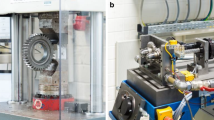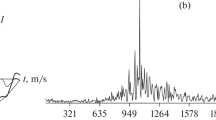Abstract
Boundary layers protect tooth flanks from solid-state contacts and, therefore, influence friction and wear. The characteristics of boundary layers (e.g. structure, chemical composition) and the running behavior of gears are determined by the manufacturing process (Klocke and Broeckmann in Prod Eng Res Dev 8(461):468, 2014; Brecher et al. in Prod Eng Res Dev 7:265–274, 2013). In this paper, the influence of the grinding fluid on the modification of boundary layers is shown. Analogy test parts are manufactured with varying fluids and additives. The differently ground test parts are measured regarding their boundary layer properties. Furthermore, the effects of the different resulting boundary layers on the running behavior are evaluated in finite life fatigue testing (pitting) on the two-disk test rig. By combining both measurement and test results, possible correlations between manufacturing and operation are investigated to establish a more sustainable and economical design of gears.










Similar content being viewed by others
References
Klocke F, Broeckmann C et al (2014) Optimized density profiles for powder metallurgical gears. Prod Eng Res Dev 8(461):468
Brecher C, Brumm M, Hübner F, Henser J (2013) Influence of the manufacturing method on the running behavior of beveloid gears. Prod Eng Res Dev 7:265–274
Brecher C, Brumm M, Greschert R (2013) Increase of strength and efficiency of gears by optimized preconditioning processes. International conference on Gears VDI-Berichte 2199.1. VDI Düsseldorf, pp 293–304
Jao TC, Inacker O, Beckmann P, Yatsunami K (2007) Effects of viscosity and surface roughness on gear contact tribological layers. Lubr Sci 19:57–70
Czichos H, Habig KH (2010) Tribologie-Handbuch. Tribometrie, Tribomaterialien, Tribotechnik. Springer, Wiesbaden
Berlet P, Dienwiebel M, Scherge M (2010) The effect of sample finishing on the tribology of metal/metal lubricated contacts. Wear 268:1518–1523
Brinksmeier E, Walter A (2000) Generation of reaction layers on machined surfaces. CIRP Ann Manuf Technol 49(1):435–438
Klocke F, Zeppenfeld C (2007) Mikroverschleißmechanismen und tribologisches Einsatzverhalten von cBN beim Schleifen mit biologisch schnell abbaubaren Kühlschmierstoffen (DFG KL 500/45-1), RWTH Aachen
Schulz J, Holweger W (2010) Wechselwirkung von Additiven mit Metalloberflächen. Expert, Renningen
Gorgels C (2011) Entstehung und Vermeidung von Schleifbrand beim diskontinuierlichen Zahnflankenprofilschleifen. Dissertation, RWTH Aachen
Weck M, Hurasky-Schönwerth O, Bugiel C (2003) Service behavior of PVD-coated gearings lubricated with biodegradable synthetic ester oils. Prod Eng Res Dev 10(2):121–126
Höhn BR, Michaelis K, Kreil O (2006) Influence of surface roughness on pressure distribution and film thickness in EHL-contacts. Tribol Int 12:1719–1725
Guideline VDI 2615 (2006) Surface roughness measurement of cylindrical gears and bevel gears by means on stylus-type instruments. Beuth, Berlin
Reichelt M, Mayer J et al (2006) TEM and nanomechanical studies on tribological surface modifications formed on roller bearings under controlled lubrication conditions. J Mater Sci 41:4543–4553
Büscher R, Fischer A (2005) The pathways of dynamic recrystallization in allmetal hip joints. Wear 259:887–897
Klocke F, Maßmann T, Gerschwiler K (2005) Combination of PVD tool coatings and biodegradable lubricants in metal forming and machining. Wear 259:1197–1206
Klocke F, Kuwer C, Zeppenfeld C (2006) Tribological analysis of diverse ceramics in contact with stainless steel under different lubricating conditions. Prod Eng Res Dev 13(2):173–176
Acknowledgments
The authors gratefully acknowledge scientific and financial support by the German Research Foundation (DFG) [Project Number BR 2905/44-1]. Furthermore, we thank Fuchs Europe Schmierstoffe GmbH for their consulting in terms of oil choice and for free supply of the applied oils. As well, we are grateful to Prof. Joachim Schulz, who contributed his ideas and experiences to our research.
Author information
Authors and Affiliations
Corresponding author
Rights and permissions
About this article
Cite this article
Brecher, C., Löpenhaus, C. & Greschert, R. Influence of the metalworking fluid on the running behavior of gear analogy test parts. Prod. Eng. Res. Devel. 9, 425–431 (2015). https://doi.org/10.1007/s11740-015-0612-0
Received:
Accepted:
Published:
Issue Date:
DOI: https://doi.org/10.1007/s11740-015-0612-0




